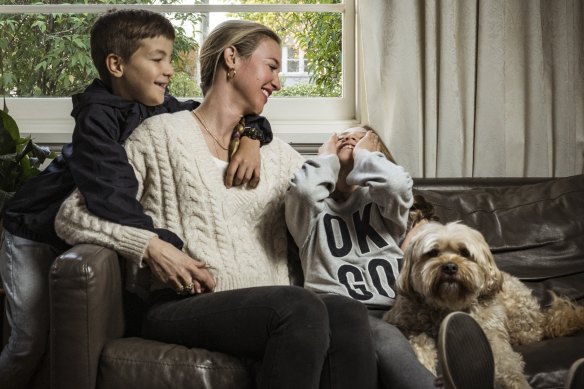Fiona Martin is a typical landlord – but she’s not what you expect

Save articles for later
Add articles to your saved list and come back to them any time.
Fiona Martin and her children live in a rented home that she can’t afford to buy. Luckily, her rent is subsidised by income from a modest investment property she is paying off.
Martin, whose investment property is in Kew, Melbourne, works as a real estate vendor advocate, helping people sell property all over Victoria. But many of her clients are now selling their investment properties because they are no longer financially worthwhile due to rising interest rates and the time it takes to manage them is “just a pain”.
Landlord and renter Fiona Martin with her eight-year-old twins Mirabelle and Miles.Credit: Chris Hopkins
While Australian landlords are often portrayed as affluent aristocrats, Martin is more typical of the more than 80 per cent of the rental market owned by individuals, or “mum and dad investors”, says Australian Landlords Association president Andrew Kent.
Most landlords report a taxable income of less than $100,000 and there are more landlords in the $18,200 to $45,000 income bracket than the $120,000 to $180,000 range, recent tax data shows. More than 300,000 people who own rental property reported a taxable income below $18,200 in 2021.
“There’s an assumption that landlords are bad and tenants deserve more because they’re poorer, because they can’t afford to buy,” Martin says. “But the majority of landlords have single investment properties and they’re families.”
Her view is borne out by the data. Landlords are likely to be households with children: about four in 10 fit the family category and two-thirds have two incomes.
The top five landlord occupations by raw numbers are: general manager, school teacher, chief executive or managing director, registered nurse and accountant. Hospitality workers – including bartenders, baristas, waiters and fast-food cooks – are the least likely landlords at about 2 per cent.
The fact that most of Australia’s landlords are working families, or middle-income earners doesn’t fit the political narrative that the “top end of town” runs most of the rental market.
However, some professions do come closer to fitting the stereotype. Surgeons, school principals and mining engineers own rental properties at some of the highest rates in Australia, with more than one in three people in these fields reporting rental income in 2021.
Tax office data back to 2012 shows a consistent pattern of people who work in jobs that pay close to an average income dominating the rental property landscape.
For example, the top 40 occupations of people who own rental properties include workers in childcare, the disability sector and aged care, motor mechanics, truck drivers, receptionists, sales assistants and police officers.
But the landlord income picture is skewed by older people and others who have low taxable incomes but own large assets. Taxable incomes can be reduced by negative gearing assets such as property and shares if the cost of owning them outweighs the income they generate each year. However, more than one million negatively-geared taxpayers received less than $10,000 in deductions from their income in 2021 and many received no net benefit because their taxable income was so low they didn’t pay any tax on it.
Managing director of the Australian Housing and Urban Research Institute, Dr Michael Fotheringham says there’s a generation, or at least cohorts of it, that have had a number of advantages and different tax settings that have enabled them to become, increasingly, the landlords to younger generations.
“If you’ve got a taxable income of less than $18,000, you’re not getting a million-dollar loan to buy that investment property,” Fotheringham says. “You’ve got assets or you’ve got a means of getting your taxable income down to that threshold.
“The skewing of who owns property towards older people is partly about natural wealth accumulation over the life cycle, but it’s also impacted by policy reforms that have made home ownership more difficult rather than easier,” Fotheringham says.
Landlords aged under 30 declined by 16,500 between 2000 and 2021, while landlords aged over 60 increased by 424,000. The over-60s are also the only age group to continue to grow landlord numbers every year since 2000.
The number of landlords owning six or more properties has increased 241 per cent since 2000, while the number with just one rose 81 per cent. Landlords with two, three or four homes have more than doubled since 2000 and those with five have more than tripled.
Changes to self-managed super funds allowing people to buy investment property supercharged the market, but more recently, there have been fewer total landlords in Australia for many reasons, Kent says.
The total number of landlords started to decline for the first time in more than 30 years in 2019.
“The public discussion of rental freezes, and abolishing negative gearing creates uncertainty in the market, and that uncertainty leads people to reconsider their investment,” Kent says.
Fotheringham says there’s “a mythology” that if you take away negative gearing, prices will go up but that’s based on Sydney prices rising in 1985-87 when prices did not go up in the rest of the country.
Splintered market
There are roughly 2.3 million Australians (about one in nine adults) who own a share of rental property. Property investors consistently borrow more than first-home buyers, creating more rental properties in the market than new homeowners. Since July 2002, investors have outspent new homeowners by $874 billion.
However, recently landlords are leaving the market and shrinking this gap (it’s down by $2 billion since the start of 2022).
Research by PEXA in March found soaring house prices enticed half of all investment property owners to exit the market within five years, which means “selling up” is the most common reason for landlord-initiated lease termination.
When rates began to rise, property prices fell and inflation spiked so many landlords sold their rental properties to owner-occupiers, delivering capital gains to investors.
Overseas investors? Not so much
Foreigners have been blamed for distorting the Australian property market but they’re a “tiny player” overall and they’re “not coming from the places you think they are”, Fotheringham says.
“When people say ‘overseas’ investors they kind of imply ‘Chinese’ investors, with a sense of menace, but actually Canada’s way up the top of the list,” he says.
In 2021-22, about 180,000 new homes were built in Australia and real estate sales exchanged 800,000 properties. Foreign buyers made up about 3 per cent of all transactions on new properties and less than 1 per cent of all property sales.
Most landlords actually lose money
Since 1994, most Australian landlords have lost money on their rental properties with an average landlord typically losing between $7000 and $14,500 a year after the deduction of expenses from rent, despite negative gearing allowing some losses to be claimed against income tax.
Sarah Strachan, 33, is a first home buyer who became a landlord in 2019 after living in her apartment in Cheltenham, Melbourne, that she owned for five years. She is now living in a house she rents with some of the income she gets from her investment property.
She describes being a landlord as stressful and taking up more headspace than she could afford while raising two small children due to legal and financial uncertainty, changes to rental rules and rate rises.
“It just felt unbalanced, our mortgage repayments were going up very quickly and we were locked into a lease, so we couldn’t raise the rent to cover that and we’d only had it as an investment for four years so we didn’t have enough equity to cover it,” Strachan says.
The cost of renovations, maintenance, property management, keeping up to date with compliance changes plus transaction costs of buying and selling the property meant they probably made a capital loss on the unit, she says.
“Some people think that you just kind of set and forget, [but] it was more headspace and stress than we were willing to give. We’ve got two young kids under five.”
The rate that properties are negatively geared has shifted below 50 per cent nationally, and declined especially quickly in Tasmania, where the rise of short-term leasing platforms such as Airbnb may be a factor.
Short-term rentals are not having a major effect in every part of the country, but where tourism is a significant part of the economy, such as in coastal communities (and Hobart), residential property has been increasingly converted into tourist accommodation, Fotheringham says.
“[Short-term rental] is financially more lucrative than having someone live in a property and it is something we need to address,” he says.
Airbnb flagged a “tourism levy” on guests to help fund social housing and other projects this year. Small guest payments are levied by the company in Barcelona, Valencia and Bali, which are then used to help fund local affordable housing and infrastructure.
Supply issues
Australia is facing a housing crisis with a shortfall of more than 100,000 homes by 2027 despite federal government plans to pump more than $100 billion into residential housing tax breaks for landlords, plus millions more via grants and tax incentives for home buyers and owners.
The Albanese government’s $10 billion housing future fund is projected to deliver 30,000 new social and affordable homes over five years but has been labelled an inadequate response by experts.
The gap between housing demand and supply in just two years is projected to be more than 45,000 homes.
NSW Tenants’ Union spokesman Leo Patterson-Ross says we need investors to help fill the housing gap because “governments are not indicating they are willing to take on the role of providing housing for everybody and are unlikely to be the dominant force of housing provision in Australia”.
How I reported this story
This story and its sister piece on renters were built on the idea that we could use data to paint a picture of who renters and landlords were, are now, and will be in the future.
I started researching and compiling data for the story in March but as I began to write, a steady stream of major reports and compelling new data kept popping up so what, I thought, might be a few days of work turned into a moving monolith.
In the end, more than 40 separate datasets and reports were used to create the stories. The best sources were ATO tax statistics for age, income, occupation and number of properties landlords own. ABS census data from 2006, 2011, 2016 and 2021 allowed me to show changes in renters and housing tenure, plus other ABS data was used for housing costs, loans, sales and more.
The Australian Housing and Urban Research Institute (AHURI) has great reports that explore housing issues. The National Housing Finance and Investment Corporation report on housing from April was used for its forecast and other data and the PEXA whitepaper series on renting helped paint a detailed picture of the rental landscape.
The Morning Edition newsletter is our guide to the day’s most important and interesting stories, analysis and insights. Sign up here.
Most Viewed in National
From our partners
Source: Read Full Article
